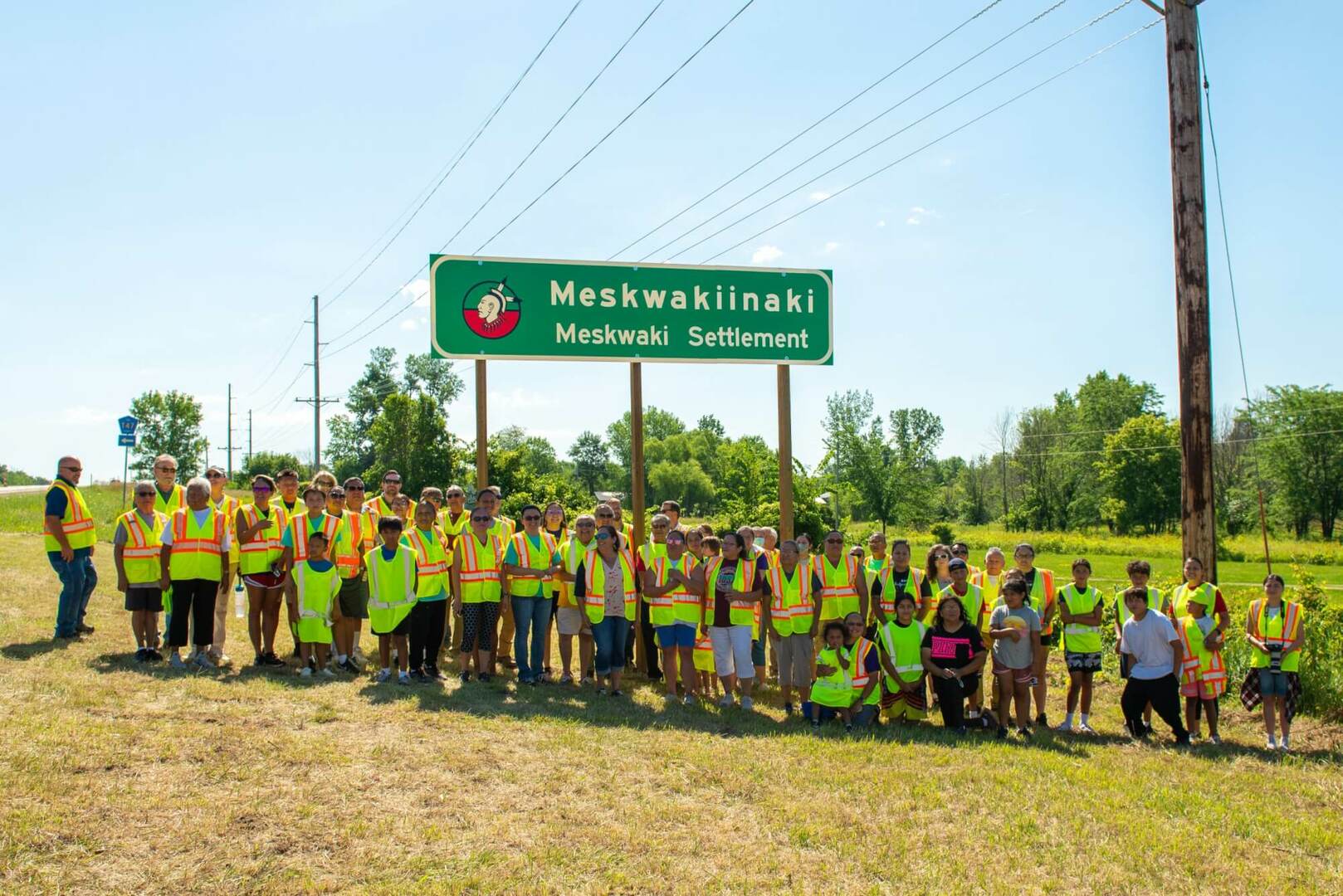Two signs reading “Meskwakiinaki” honoring Iowa’s only federally recognized Indian Tribe were unveiled by the Iowa Department of Transportation (DOT) during Meskwaki Nation Day commemorative activities on Wednesday, July 13, 2022. The Meskwaki Settlement, comprised of more than 8,624 acres, is now book ended by the signs on U.S. Highway 30 west of Tama. Iowa joins seven other states that boast dual language signs on Native lands.
Lawrence SpottedBird, Meskwaki Nation Executive Director, expressed, “Today is a great day that shows respect to the Meskwaki people, their language and their culture. The sign reads ‘Meskwakiinaki’ which translates to ‘Land of Meskwaki’. It’s a wonderful symbol that now identifies the land owned by the Sac and Fox Tribe of the Mississippi in Iowa to those passing through. We appreciate the Iowa DOT for keeping this project alive and seeing it come to fruition.”
With more than 150 Indigenous languages still spoken today and more than 5.2 million Indigenous people living in the U.S., the Iowa and Minnesota DOTs, along with many Indigenous partners, sought to acknowledge sovereign nations and their boundaries and bring their spoken languages to the forefront to travelers.
In May of 2021, Meskwaki Nation made a formal request to the Iowa DOT for the signage with installation earlier this month. It was a project that was years in the making.
According to an ETAP podcast about the road signs, Minnesota and Iowa DOTs began working together in 2017 during a Tribal Summit held at the Meskwaki Settlement. Seeking to communicate to the traveling public more about local Indigenous communities and to help keep Indigenous language revitalization and educational efforts at the forefront, their brainstorming began.
Brendon Dolan, the Cultural Resources Team Lead and Tribal Liaison with Iowa DOT, said, “It just seemed like one of those opportunities to do a lot with a process and product we already create thousands of around the state. We put up signs all over on many subjects, directional, safety issues, [etc.,] and duel language signage seemed like a simple thing for us to utilize to further connect with the tribes we work with.”
The biggest obstacle to the initiative was the written component. Most Native languages were not originally created in written form. They were passed down from generation to generation orally. Honoring these original oral teachings while working to create them in written form is an ongoing project for many tribes.
Mary Otto (Ojibwe), Tribal State Relations Training Manger for Minnesota DOT’s Office of Tribal Affairs explained, “Out of honor and respect to those who came before us in learning the language, yet living in the way we do today, we are able to live in both worlds. This means by observing, revitalizing, using our language and practicing our traditional, cultural ways of life while walking in the [modern] world by managing career and living with technology and that side of things, we show others that we still exist. Language is alive, language has a spirit. [This signage] is an advancement for our youth and for revitalizing our languages, to show others our language is still alive and that we are still here.”
On the podcast, she went on to quote a White Earth elder who stated, “We are not losing our language, the language is losing us.” She explained, “Before European contact, our language was everything we needed. Our stories, our values, our teachings, were all lessons for our children.” As a former teacher, she explained how children learn differently today and a big part of that learning process involves a visual aspect. As revitalization work continues throughout tribal nations and as children and families are driving down the road, it can be very significant and empowering for them to be able to connect their language to everyday life.
Through this project, Indigenous people can see their homeland and their language as their own and others can be reminded that they are entering sovereign land. For these reasons, the signage is written with the Native language on top with English on the bottom.
It was a beautiful day for the Meskwaki and a big crowd was on hand along U.S. Highway 30 during the unveiling. As revitalization efforts continue, the Meskwaki Language Preservation Department presents the passionate overview of the importance of maintaining cultural identity through the everyday use of the Meskwaki language among the community. Wayne Pushetonequa, Meskwaki Language Preservation Director, advised, “Our language carries our identity. We, the Meskwaki people, will remain strong in our culture, past, present, and future, by continuing to speak our language. We thank the Iowa DOT for helping us to do so in this way.”
To hear the entire podcast about the new signs, go to: https://aashtos-etap-podcast.simplecast.com/episodes/aashtos-etap-podcast-native-language-road-signs-with-iowa-and-minnesota-dots-WhsXrIBA
To view the pictures from the unveiling of the Meskwaki duel language sign, go to: https://meskwakimedia.smugmug.com/Dual-Language-Sign/

